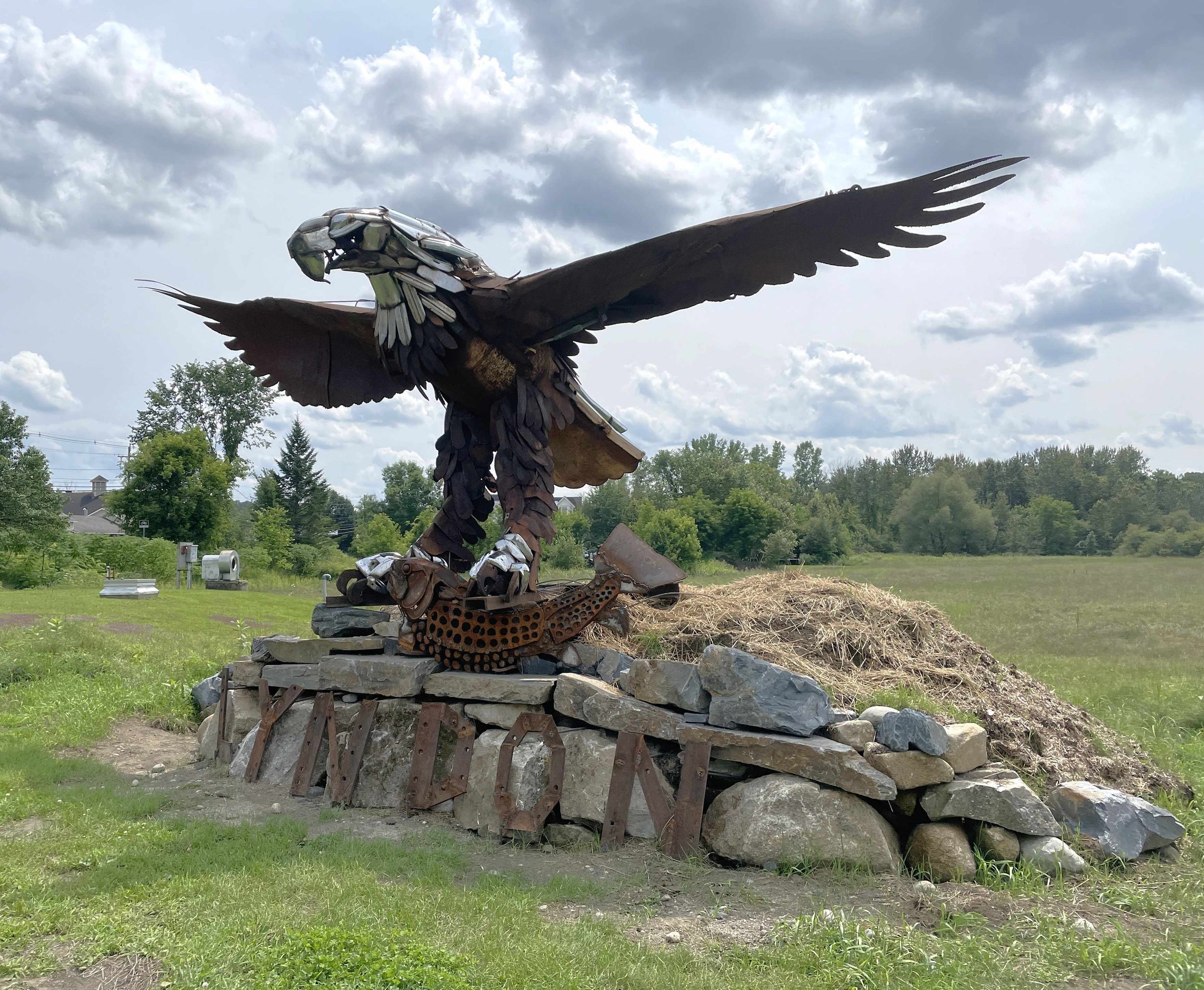Empty nest: Popular Rt. 100 curiosity lands at new public park in Lyndon
August 5, 2023 | By Cheryl Casey | CorrespondentThe eagle gets loaded up to move out of Waterbury. Photo by Francine Chittenden
Eagle-eyed travelers on Route 100 in Waterbury Center might notice something missing from the landscape: the chrome and scrap metal eagle sculpture has flown the coop.
The eagle, created by Vermont sculptor Martin McGowan, was recently removed from the gravel pull-off at the head of Francine and Eric Chittenden’s driveway on the southbound side of Rt. 100. Installed in August 2020, it replaced McGowan’s 12-foot-tall scrap metal steed, which now gallops at Shelburne Green commercial park on U.S. Rt. 7.
Poised as if to take flight with a wingspan just under 25 feet, the eagle has landed in McGowan’s hometown of Lyndon in what will be the new Sanborn Bridge Riverfront Park. McGowan confirmed that the sculpture “was purchased and is now owned by Lyndon by way of a Vermont Arts Council grant.”
With the help of his son Beck, McGowan installed the eagle on a new rock base – a “mini-mountain,” as McGowan called it. “I changed it up because I built a 7-foot-long trout that the eagle has its [talons] on, like it’s just gonna have it for dinner,” he explained. Along the rock base are scrap metal letters spelling, “Lyndon.”
“It’s elevated…and it looks really neat,” McGowan said. “It kind of looks like it’s on the edge of a cliff or something like that.”
The Town of Lyndon purchased the Sanborn Covered Bridge and the abutting 2 acres along the Passumpsic River in February 2022 and has embarked on a $1.5 million project to restore the historic bridge, according to the town’s website. The adjacent park will complete the scene as an attractive area for recreation and tourism.
Although presently living in Newark, McGowan was raised in Lyndon. “It’s pretty cool. It’s my hometown. That’s where I grew up and went to school, and my dad lives in Lyndonville,” he said.
Martin McGowan's eagle sculpture has a new perch at the site of a park being built in Lyndon. Photo by Kaja McGowan
Supportive arts hosts
After making McGowan’s acquaintance by chance several years ago, the Chittendens “called him out of the blue to offer to host the horse sculpture,” explained Francine Chittenden.
“We were just happy to have it and have people see it. It was good exposure for him,” Eric Chittenden said of McGowan.
“It is kind of a nice spot for people to be able to see a sculpture when they drive by,” McGowan agreed.
With the Waterbury Reservoir and Camel’s Hump in the background, both the horse and then the eagle made for popular photo ops with travelers. Eric Chittenden even marveled at how the eagle “ended up getting on Google Maps somehow.”
McGowan said he learned about map reference when preparing for the recent move. He recounted how, when he asked his friend who was driving the crane truck if he remembered where he was going, the friend replied, “Well, I looked it up on Google Maps.”
The eagle standing along Route 100 last November. File photo by Lisa Scagliotti
A hole in the scenery
Now the gravel pull-off sits empty and quiet. The Chittendens confessed that they would happily host another McGowan sculpture in the space. “It’s a great venue, and most people are very respectful,” Francine Chittenden said. “We’re not artists ourselves, but we love to support artists,” she added.
McGowan can’t say what might come next, or when. “I don’t really have anything done yet,” he said, “so it’s going to be a while.”
Martin McGowan's wild mustang sculpture was the first large artwork he displayed along Rt. 100 in Waterbury Center. It moved to Shelburne in 2020. File photo by Karen Cavender
Artists like McGowan usually have to pay out-of-pocket to display their work so that it attracts the attention of potential buyers. Moving the work around cuts into what money artists can make.
McGowan isn’t ready to reveal his latest project, but it sounds as if it’s on a different scale than the eagle and the horse before it. “The thing I’m working on now is so massive, it may just be too costly,” he said. “[It’s] so big that I’ll have to specially engineer it so it could go over the road, which would be awesome… I’ll likely need to find a buyer for it first before I move it. We’ll see what happens. It’s a great spot.”
Meanwhile, eagle-eyed travelers around Vermont might spot other works by McGowan. Besides the two sculptures that spent time along Rt. 100 in Waterbury, he created a 30-foot-long dragon atop the Village Center Apartments in Morrisville, a chimera in East Burke, and a bust in the permanent collection of Lemon Fair Sculpture Park in Shoreham.
Waterbury Center resident Cheryl Casey is a professor of communication at Champlain College and president of the Waterbury Historical Society.




